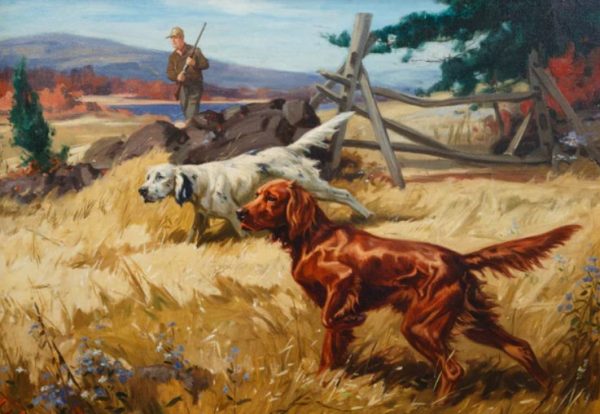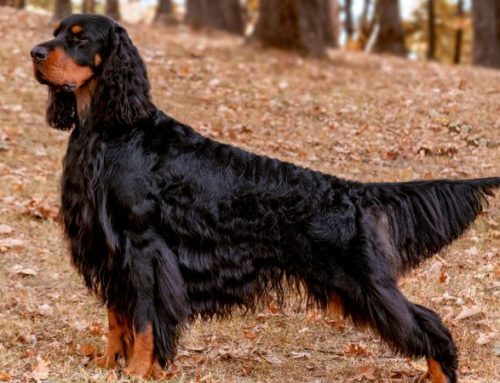A fascinating journey into the origins of hunting with setters, exploring their different bloodlines and distinctive characteristics. We will discover how this noble pointing dog has evolved over the centuries, becoming an indispensable hunting companion and a symbol of elegance and tenacity.
The world of hunting is rich in tradition, passion and dedication. Among the most popular and well-known hunting dogs, setters occupy a place of honor. These dogs, divided into three main breeds – the English Setter, the Gordon Setter and the Irish Setter – have a fascinating history and a fundamental role in hunting. In this article, we will explore the origins and characteristics of each of these breeds, providing a comprehensive overview for enthusiasts and hunters.
Origins and development of the setter breeds
Setters are specialized hunting dogs, known for their ability to locate and signal the presence of game with the typical “still” pose. Their history is intertwined with that of hunting in Europe, where they were selected and bred to meet the needs of local hunters. The three main setter breeds, the English Setter, the Gordon Setter and the Irish Setter, have distinct origins but share many common characteristics.
The Origin of the English Setter
The English Setter has ancient origins dating back to the 15th century. Originally developed in England, this dog was derived from ancient spaniels and other hunting breeds. Its name derives from the English word “to set”, which means “to place”, in reference to its ability to indicate the position of the game. Selective breeding began in the 18th century, with the significant contribution of Edward Laverack, considered the father of the modern breed. Laverack selected dogs for their aesthetic and hunting qualities, leading to the creation of the English Setter as we know it today.
Development and diffusion
Edward Laverack was not the only one to contribute to the development of the English Setter. Richard Purcell Llewellin was another breeder of great importance, who crossed Laverack dogs with other setter lines to improve their hunting abilities. These crosses led to the creation of a line of setters particularly adept at hunting feathered game, known as the Llewellin Setter. The English Setter quickly gained popularity not only in England, but also in the United States and other parts of the world, thanks to its exceptional hunting qualities and balanced temperament.
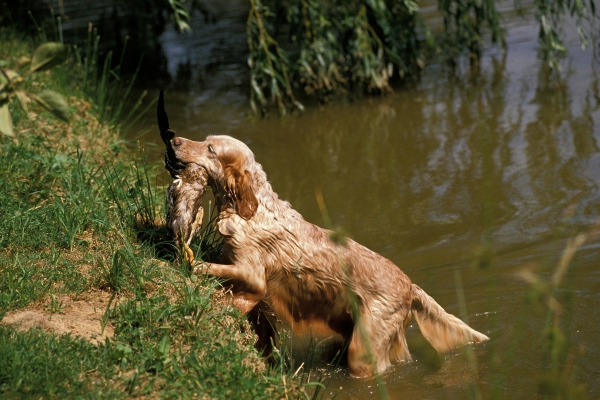
The story of the gordon setter
The Gordon Setter, often referred to as the Scottish Setter, has a fascinating history deeply rooted in the rugged landscapes of Scotland. This noble breed was developed in the 18th century by Alexander Gordon, the 4th Duke of Gordon, whose vision for the perfect hunting dog shaped the characteristics of the Gordon Setter we know today. The Duke, an avid sportsman and a lover of hunting, sought to create a dog that could thrive in Scotland’s challenging terrain and unpredictable weather. Through careful selection, he focused on dogs that possessed not only exceptional hunting skills but also unparalleled endurance, loyalty, and adaptability.
One of the distinguishing features of the Gordon Setter is its striking appearance. Unlike its lighter-built relative, the English Setter, the Gordon Setter is stockier and more muscular, exuding strength and resilience. Its glossy black coat, accented with rich, fiery tan markings, is as practical as it is beautiful, offering protection from harsh weather while making the dog easily visible in the field. This iconic look, combined with the breed’s intelligence and focus, made it a favorite among hunters who valued both form and function.
Breeding characteristics
The breeding process that led to the creation of the Gordon Setter was as meticulous as it was innovative. The Duke of Gordon is believed to have crossed various breeds, including spaniels, collies, and possibly even bloodhounds, to achieve the ideal combination of traits. Each element of this breeding program was deliberate: the spaniels likely contributed to the breed’s sharp hunting instincts and work ethic, the collies added intelligence and loyalty, and the potential influence of the bloodhound enhanced its tracking abilities. The result was a dog with a powerful build, remarkable stamina, and the mental focus needed for long days in the field.
What truly set the Gordon Setter apart was its ability to excel in adverse conditions. Scotland’s terrain, characterized by rocky hills, dense brush, and marshy grounds, demanded a dog that could maintain a steady pace and perform with precision, regardless of the challenges. The Gordon Setter’s endurance allowed it to cover vast areas of ground methodically, making it an invaluable companion for hunters who needed a reliable partner capable of sustaining its energy throughout the day.
The breed’s adaptability further cemented its reputation as an exceptional hunting dog. It could transition seamlessly between different types of terrain and hunting environments, demonstrating an impressive ability to adjust to the needs of its owner. Whether tracking game in thick forests or traversing open fields, the Gordon Setter consistently proved its worth through its versatility and determination.
Over time, the Gordon Setter’s reputation spread beyond Scotland, captivating hunting enthusiasts worldwide. Its combination of strength, beauty, and skill made it a sought-after breed, not only for its hunting prowess but also for its loyal and affectionate nature, which endeared it to families as well. Today, the Gordon Setter continues to be celebrated as a testament to the dedication and vision of the Duke of Gordon, a breed that embodies the spirit of resilience and excellence.
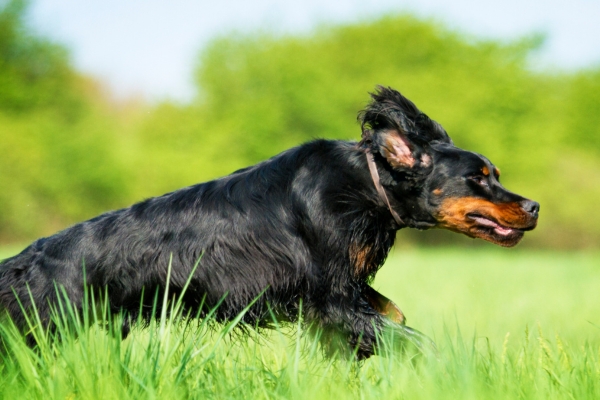
The roots of the irish setter
The Irish Setter has a fascinating history that is intertwined with that of Ireland. This breed was developed in the 18th century, probably by crossing various spaniels, pointers and other local hunting breeds. The Irish Setter is known for its bright red coat and its speed and agility. Originally used as a hunting dog for feathered game, the Irish Setter quickly became popular due to its exceptional hunting skills and elegant appearance.
Evolution and popularity
The breeding of the Irish Setter initially focused on obtaining a fast and resistant dog, capable of working on open and rough terrain. The selection focused on dogs with a bright red coat, which became one of the distinctive features of the breed. In the 19th century, the popularity of the Irish Setter grew both in Europe and in the United States, where it was appreciated not only as a hunting dog, but also as a show dog. His beauty and lively temperament made him a favorite among dog lovers.
Characteristics and use in hunting
Each setter breed has developed unique characteristics that make it suitable for specific types of hunting and terrain. Let’s explore the peculiarities of each breed in detail.
The english setter: elegance and precision
The English Setter is known for its elegance and precision in hunting. These dogs are medium in size, with a silky coat that can be white with black, orange or liver markings. They are agile and fast dogs, capable of covering large distances in a short time. The English Setter is particularly prized for its ability to work across open terrain and locate game with great precision. Their standing is one of the most distinctive characteristics, with the dog posing in a static position and pointing towards the prey.
Hunting skills
The English Setter was bred to excel at hunting feathered game, such as pheasants, partridges and quail. These dogs have a great ability to cover large areas of ground, using their excellent sense of smell to locate prey. Their pointing is a moment of great elegance, with the dog remaining motionless, indicating the position of the game to the hunter. This feature makes them particularly valuable in hunting environments where precision and discretion are essential.
The gordon setter: endurance and tenacity
The Gordon Setter is the most robust of the setters, with a heavier and more muscular body structure. This makes it particularly suitable for difficult terrain and adverse weather conditions. Its black coat with fire-colored spots is dense and weatherproof. The Gordon Setter is known for its tenacity and endurance, qualities that make it ideal for long days of hunting in mountainous or wooded environments. Their ability to work as a team and track game makes them excellent hunting companions.
Work characteristics
The Gordon Setter is prized for its ability to hunt in difficult terrain and in adverse weather conditions. His physical resistance allows him to work for long hours without getting tired, always maintaining high concentration. This breed is particularly effective at hunting feathered game and searching for wounded game, thanks to its ability to follow subtle tracks and maintain visual contact with the hunter. Their strong bond with the owner and their natural obedience make them easy to train and handle in the field.
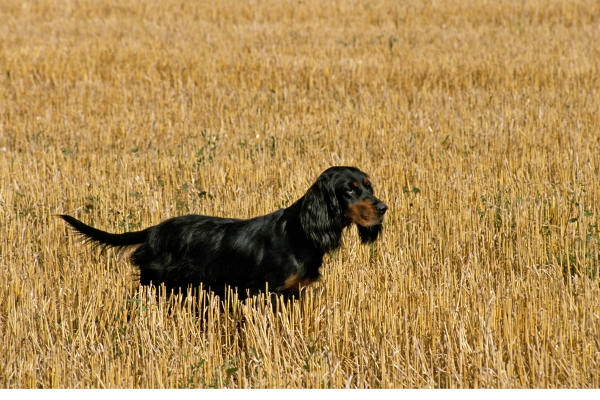
The irish setter: speed and agility
The Irish Setter is famous for its speed and agility. Lighter in build than the Gordon Setter, this dog has a bright red coat that makes it easily recognizable. They are energetic and lively dogs, capable of covering large hunting areas in a short time. The Irish Setter is particularly effective at hunting feathered game, thanks to its ability to move quickly and stop decisively when it spots prey. Their lively nature and their ability to adapt to various types of terrain make them very versatile hunting dogs.
Hunting specializations
The Irish Setter was selected for hunting over open terrain and for the ability to cover large distances quickly. Their speed makes them particularly suited to hunting fast-moving feathered game, such as pheasants and quail. Their ability to suddenly stop when they spot game is a key feature, allowing the hunter to get close and prepare to shoot. This combination of speed, agility and stopping ability makes them an invaluable tool for any hunter.
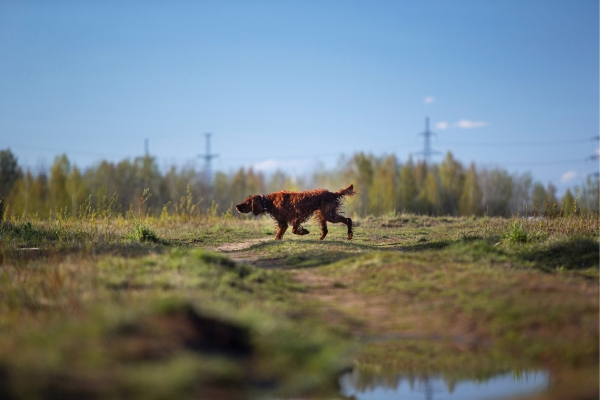
The modern evolution of setters
Over time, setter breeds have undergone various changes and adaptations, both in terms of breeding and use in hunting. Today, these breeds are prized not only for their hunting abilities, but also as companion and show dogs.
The english setter today
The English Setter has maintained its popularity as both a hunting dog and a companion dog. Modern breeding focuses not only on hunting skills, but also on appearance and temperament. These dogs are known for their friendly and sociable nature, which makes them excellent pets. However, their hunting roots remain strong, and many English Setters are still used on hunting trips around the world.
Modern adaptations
English Setter breeders today focus on the health and longevity of the breed, selecting dogs with good physical structure and balanced temperament. This has resulted in a breed that is not only efficient at hunting, but also an affectionate and loyal companion. Beauty competitions and working trials continue to be popular among English Setter owners, who appreciate the versatility and elegance of these dogs.
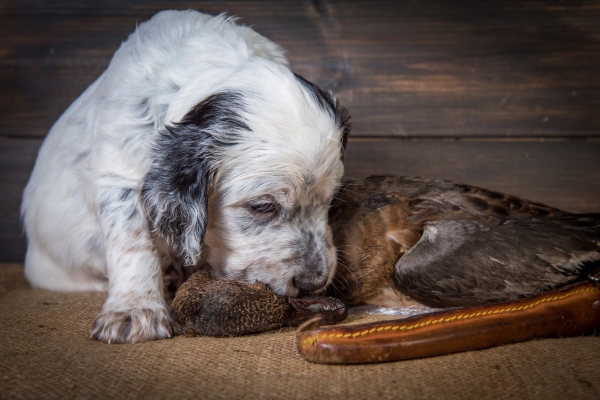
The gordon setter in the contemporary world
The Gordon Setter has maintained its reputation as a robust and hardy dog. Modern selection has focused on maintaining its physical qualities and hunting skills. In addition to being used in hunting, Gordon Setters are popular in obedience and agility competitions, thanks to their intelligence and ability to learn. Their affectionate and loyal nature also makes them excellent family companions.
Innovations in breeding
Modern Gordon Setter breeders have focused on eliminating genetic problems and optimizing the breed’s hunting abilities. This has resulted in dogs that are not only excellent hunters, but also healthy, long-lived pets. Their endurance and ability to work in harsh conditions continues to be valued, making the Gordon Setter a popular choice among hunters who need a reliable and hardy dog.
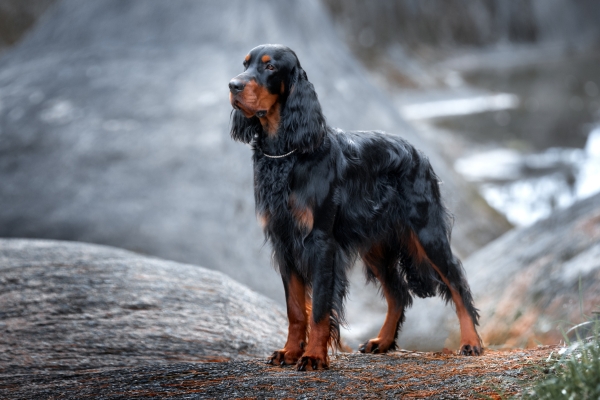
The current irish setter
The Irish Setter continues to be one of the most popular setter breeds. Their aesthetic beauty and lively temperament make them popular as both hunting dogs and companion animals. Modern breeders focus on maintaining health, beauty and hunting skills. Irish Setters are often seen in dog shows and agility competitions, where they display their elegance and agility. However, their passion for hunting remains intact, and many of them are still used for hunting feathered game.
The impact of modern selection
Modern breeding has improved many aspects of the Irish Setter, making it a balanced and versatile dog. Breeders focus on preventing hereditary diseases and improving the breed’s physical and mental capabilities. This has led to a population of Irish Setters that are not only beautiful to look at, but also highly functional as hunting dogs. Their popularity in agility competitions and dog shows is a testament to their versatility and enduring appeal.
The history of setters is rich in tradition and innovation. From their origins as hunting dogs selected for their specific abilities, to modern breeds prized for their beauty and character, setters continue to hold a special place in the hearts of hunters and dog lovers. The English Setter, the Gordon Setter and the Irish Setter represent not only excellence in hunting, but also the dedication and passion that breeders and owners have put into the maintenance and development of these extraordinary breeds. With their elegant demeanor, hunting prowess, and affection, setters will continue to be treasured for generations to come.


